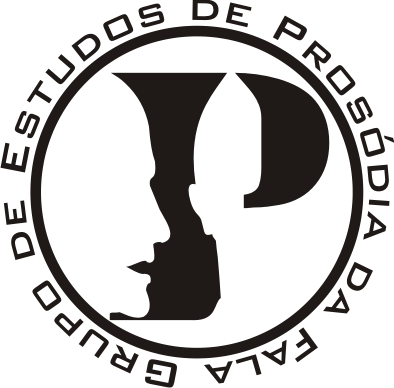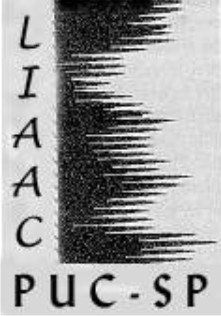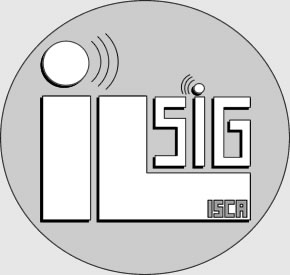
Technical Program
Observations
Page refer to initial page in the Proceedings. When loading file from
this file pages are not indicated. Please refers to the proceedings,
where an author index is found at the end of the volume.
Papers with sound files available in the 'sounds' folder are indicated
by an icon (the papers indicate what to hear).
Credits and how to cite
Please open the Credits and How to cite html
files.
Keynote Session 1
- Robert F. Port (page 7)
- All is prosody: Phones and phonemes are the ghosts of letters
Keynote Session 2
- Yi Xu (page 17)
- Multi-dimensional information coding in speech
Poster Session 1: Voice Quality in Prosody Research
- Marko Lugger, Frank Stimm, Bin Yang (page 29)
- Extracting voice quality contours using discrete hidden Markov models
- Tae-Jin Yoon, Jennifer Cole, Mark Hasegawa-Johnson (page 33)
- Detecting non-modal phonation in telephone speech
- Xiaodan Zhuang, Mark Hasegawa-Johnson (page 37)
- Towards interpretation of creakiness in switchboard
- Sabrina Cukier-Blaj, Zuleica Camargo, Sandra Madureira (page 41)
- Long-term average spectrum loudness variation in speakers with asthma, paradoxical vocal fold motion and without breathing problems
- Carlos Toshinori Ishi, Hiroshi Ishiguro, Norihiro Hagita (page 45)
- The roles of breathy/whispery voice qualities in dialogue speech (Sound examples)
- Gláucia Laís Salomão (page 49)
- Relationship between perceived vocal registers and glottal flow parameters
- Grazyna Demenko (page 53)
- Voice stress extraction
- Zuleica Camargo, Sandra Madureira (page 57)
- Voice quality analysis from a phonetic perspective: Voice Profile Analysis Scheme (VPAS) profile for Brazilian Portuguese (Sound examples)
Poster Session 2: Prosody in Speech Technology
- Gérard Bailly, Alex Bartroli (page 63)
- Generating Spanish intonation with a trainable prosodic model
- Sacha Krstulovic, Javier Latorre, Sabine Buchholz (page 67)
- Comparing QMT1 and HMMs for the synthesis of American English prosody
- Qing Guo, Jie Zhang, Nobuyuki Katae (page 71)
- Prosodic word grouping with global probability estimation method
- Lidong Luo Xingchi Xian (page 75)
- Integration of intonation in trainable speech synthesis
- Woosung Kim (page 79)
- Using prosody for automatically monitoring human-computer call dialogues
- Pablo Daniel Agüero, Juan Carlos Tulli, Antonio Bonafonte (page 83)
- A new clustering approach for JEMA
- Pablo Daniel Agüero, Juan Carlos Tulli, Antonio Bonafonte (page 87)
- Pause transfer in the speech-to-speech translation domain
- Yi Su, Frederick Jelinek (page 91)
- Exploiting prosodic breaks in language modeling with random forests
- Qinghua Sun, Keikichi Hirose, Nobuaki Minematsu (page 95)
- Improved prediction of tone components for F0 contour generation of Mandarin speech based on the tone nucleus model
- Deepa P. Gopinath, Veena S.G., Achuthsankar S. Nair (page 99)
- Modeling of vowel duration in Malayalam speech using probability distribution
- Natalia Segal, Philippe Martin, Katarina Bartkova (page 103)
- Prosodic trees for boundary detection in ASR in French
- Viet-Anh Tran, Gérard Bailly, Hélène Loevenbruck, Tomoki Toda (page 107)
- Predicting F0 and voicing from NAM-captured whispered speech
- Damien Lolive, Nelly Barbot, Olivier Boeffard (page 111)
- Pitch and duration transformation with non-parallel data
- Cédric Boidin, Olivier Boeffard (page 115)
- Modeling intonation variability with HMM for speech synthesis
- Mathieu Avanzi, Anne Lacheret-Dujour, Bernard Victorri (page 119)
- ANALOR: A tool for semi-automatic annotation of French prosodic structure
- Hyongsil Cho, Stéphane Rauzy (page 123)
- Phonetic pitch movements of accentual phrases in Korean read speech
- Daniel Hirst, Saandia Ali (page 127)
- Optimizing the automatic functional annotation of English intonation
- José Albos Rodrigues, Benedito Guimarães Aguiar Neto, Maria Auxiliadora Bezerra (page 131)
- Frontema: A unit for the study of word boundaries
- Céline De Looze, Daniel Hirst (page 135)
- Detecting changes in key and range for the automatic modelling and coding of intonation
- Sunhee Kim, Daniel Hirst, Hyungsil Cho, Ho-Young Lee, Minhwa Chung (page 139)
- Korean MULTEXT: A Korean prosody corpus
- Yuan-Fu Liao, Wen-Chieh Chang, Zong-You Xie, Ding-Yun Zeng, Yau-Tarng Juang (page 143)
- Joint prosodic and spectral modeling for robust speaker verification
- Philippe Martin (page 147)
- A fundamental frequency estimator by crosscorrelation of adjacent spectra
- Kornel Laskowski, Jens Edlund, Mattias Heldner (page 151)
- Learning prosodic sequences using the fundamental frequency variation spectrum
- Chen Hua, Wen Qiufang, Li Aijun (page 155)
- A learner corpus - ESCCL
Oral Session 1: Prosody in Speech Recognition and Understanding
- Sankaranarayanan Ananthakrishnan, Shrikanth Narayanan (page 161)
- Data-driven unsupervised adaptation of acoustic-prosodic models
- Jui-Ting Huang, Mark Hasegawa-Johnson, Chilin Shih (page 165)
- Unsupervised prosodic break detection in Mandarin speech
- N. Minematsu, T. Nishimura, D. Saito, S. Asakawa, Y. Qiao (page 169)
- Holistic and prosodic representation of the segmental aspect of speech
Keynote Session 3
- Elliot Saltzman, Hosung Nam, Jelena Krivokapic, Louis Goldstein (page 175)
- A task-dynamic toolkit for modeling the effects of prosodic structure on articulation
Oral Session 2: Speech Pathology
- Arantza del Pozo, Steve Young (page 187)
- Repairing tracheoesophageal speech duration
- Bernadette Cardoso, César Reis (page 191)
- Variables for the study of the temporal organization in speech disorders
- Marie-Thérèse Le Normand, Sarah Boushaba, Anne Lacheret-Dujour (page 195)
- Prosodic disturbances in autistic children speaking French
- Luisa Barzaghi, Beatriz Mendes (page 199)
- Stressed and unstressed vowel production in hearing-impaired speech
Special Session 1: Human Voices and Emotion, Functional Brain Imaging Insights
- Silke Paulmann, Patricia Schmidt, Marc Pell, Sonja A. Kotz (page 205)
- Rapid processing of emotional and voice information as evidenced by ERPs
- Annett Schirmer, Nicolas Escoffier, Angela D. Friederici (page 211)
- Out of the spotlight: Neurophysiological mechanisms underlying the processing of unattended vocal expressions
- Dirk Wildgruber, Thomas Ethofer, Benjamin Kreifelts, Didier Grandjean (page 217)
- Cerebral processing of emotional prosody: a network model based on fMRI studies
- Didier Grandjean, Klaus R.Scherer (page 223)
- Neuronal synchronization during auditory emotional perception
Poster Session 3: Tone, Accent and Intonation
- Nancy Hedberg, Juan M. Sosa, Emrah Görgülü (page 229)
- Early and late nuclei in yes-no questions: Tails or high rises?
- Margje Post (page 233)
- Post-nuclear prominence patterns in Northern Russian question intonation
- Hila Green, Yishai Tobin (page 237)
- Intonation in Hebrew-speaking children with high-functioning autism: a case study
- Hye-Sook Lee (page 241)
- Non-rising questions in North Kyeongsang Korean
- Doris Mücke, Martine Grice, Anne Hermes, Johannes Becker (page 245)
- Prenuclear rises in Northern and Southern German
- Nima Sadat-Tehrani (page 249)
- The structure of Persian intonation
- Yiya Chen (page 253)
- Revisiting the phonetics and phonology of Shanghai tone sandhi
- Plínio A. Barbosa (page 257)
- Prominence- and boundary-related acoustic correlations in Brazilian Portuguese read and spontaneous speech
- Hansjörg Mixdorff, Yuping Wang, Yu Hu (page 261)
- Robustness of tonal and segmental information in noise - Auditory and visual contributions
- Vered Silber-Varod, Loïc Kessous (page 265)
- Prosodic boundary patterns in Hebrew: A case study of continuous intonation units in weather forecast
- Gilbert Ambrazaitis, Oliver Niebuhr (page 269)
- Dip and hat pattern: a phonological contrast of German?
- Alejna Brugos, Nanette Veilleux, Mara Breen, Stefanie Shattuck-Hufnagel (page 273)
- The alternatives (Alt) tier for ToBI: Advantages of capturing prosodic ambiguity
- Seung-Eun Chang (page 277)
- Perception of South Kyungsang Korean tones
- Luciana Lucente, Plínio A. Barbosa (page 281)
- Narrow focus in Brazilian Portuguese: spatial and temporal constraints
- Noam Amir, Bat-Chen Almogi, Hansjörg Mixdorff (page 285)
- A systematic framework for studying the contribution of F0 and duration to the perception of accented words in Hebrew
- Adrian Leemann, B. Siebenhaar (page 289)
- Swiss Alpine and Midland Intonation
- Barbara Gili Fivela (page 293)
- Broad focus vs contrastive focus: Is there categorical perception in Pisa Italian?
- Carlos Gussenhoven (page 297)
- Semantic judgments as evidence for the intonational structure of Dutch
- Caterina Petrone, Mariapaola D’Imperio (page 301)
- Tonal structure and constituency in Neapolitan Italian: Evidence for the accentual phrase in statements and questions
- Jian Jin, Weixiang Hu, Xia Wang, Ziyu Xiong (page 305)
- A comparative study on tone realization in Cantonese-accented Mandarin and standard Mandarin
- Udo Will, Nick Poss (page 309)
- The role of pitch contours in tonal languages processing
- Osamu Fujimura (page 313)
- Pitch Accent in Japanese: Implementation by the C/D model
- Geneviève Caelen-Haumont (page 317)
- Structuring F0 prominences (melisms): an analysis of the statistical concordances between four French speakers
Poster Session 4: Rhythm and Tempo
- Nigel G. Ward, S. Kumar Mamidipally (page 323)
- Factors affecting speaking-rate adaptation in task-oriented dialogs
- Alexsandro R. Meireles, Plínio A. Barbosa (page 327)
- Speech rate effects on speech rhythm
- Oliver Niebuhr (page 331)
- The effect of global rhythms on local accent perceptions in German
- Emily Nava, Maria Luisa Zubizarreta (page 335)
- Prosodic transfer in L2 speech: Evidence from phrasal prominence and rhythm
- Riikka Ullakonoja (page 339)
- Pausing as an indicator of fluency in the Russian of Finnish learners
- José Olímpio de Magalhães, Maria Dorotéa Sales Barbosa, Ceriz Graça Bicalho Cruz Costa (page 343)
- The pace of the delivery of speech in contexts with the preposition 'de' in BH Portuguese (Sound examples)
- Rosa Giordano (page 347)
- On the phonetics of rhythm of Italian: patterns of duration in preplanned and spontaneous speech
- Katarina Bartkova (page 351)
- Rhythmic patterns and their automatic retrieval in spontaneous French
- Michael L. O'Dell, Mietta Lennes, Tommi Nieminen (page 355)
- Hierarchical levels of rhythm in conversational speech
- Anne Tortel, Daniel Hirst (page 359)
- Rhythm and rhythmic variation in British English: Subjective and objective evaluation of French and native Speakers
- Laurence White, Katalin Mády (page 363)
- The long and the short and the final: Phonological vowel length and prosodic timing in Hungarian
- Valérie Pasdeloup, Robert Espesser, David Piotrowski, Malika Faraj (page 367)
- Form and substance relationship in rhythmic structuring: a morphodynamic analysis of rate sensitivity at the infra-syllabic level
- João Paulo Teixeira, Diamantino Freitas (page 371)
- Phoneme dedicated ANN improves segmental duration model
- Volker Dellwo (page 375)
- The role of speech rate in perceiving speech rhythm
- Annie C. Gilbert, Victor J. Boucher, Boutheina Jemel (page 379)
- Size of rhythm-groups affects the memory trace of heard words in utterances: Results from a pilot study using evoked potentials
- Zofia Malisz, Katarzyna Klessa (page 383)
- A preliminary study of temporal adaptation in Polish VC groups
Keynote Session 4
- João Antônio de Moraes (page 389)
- The pitch accents in Brazilian Portuguese: analysis by synthesis
Oral Session 3: Syntax, Semantics, Pragmatics and Prosody
- Agustín Gravano, Stefan Benus, Julia Hirschberg, Elisa Sneed German, Gregory Ward (page 401)
- The effect of contour type and epistemic modality on the assessment of speaker certainty
- Joshua Tauberer (page 405)
- Predicting intrasentential pauses: Is syntactic structure useful?
- Diana Dimitrova, Gisela Redeker, Markus Egg, John Hoeks (page 409)
- Linguistic and extra-linguistic determinants of accentuation in Dutch
- Catherine Lai (page 413)
- Prosodic cues for backchannels and short questions: Really?
Oral Session 4: Speech Rhythm and its Measures
- Michela Russo and William J. Barry (page 419)
- Isochrony reconsidered. Objectifying relations between rhythm mesures and speech tempo
- Peggy P.K. Mok, Volker Dellwo (page 423)
- Comparing native and non-native speech rhythm using acoustic rhythmic measures: Cantonese, Beijing Mandarin and English
- Pier Marco Bertinetto, Chiara Bertini (page 427)
- On modeling the rhythm of natural languages
- Erin O’Rourke (page 431)
- Speech rhythm variation in dialects of Spanish: Applying the pairwise variability index and variation coefficients to Peruvian Spanish
Poster Session 5: Prosody and Higher Linguistic Domains
- Amanda Edmonds, Audrey Liljestrand Fultz, Jason Killam (page 437)
- Prosody and the production of ambiguous relative clauses in French
- Elsa Mora, Hernán Martínez (page 441)
- Prosodic characteristics associated with the clause in Venezuelan Spanish: an acoustic, audio-perceptive analysis
- Luciani Ester Tenani, Flaviane Romani Fernandes-Svartman (page 445)
- Prosodic phrasing and intonation in neutral and subject-narrow-focus sentences of Brazilian Portuguese
- Aijun Li, Yiqing Zu (page 449)
- Speaking rate effects on discourse prosody in standard Chinese
- Vivek Kumar Rangarajan Sridhar, Ani Nenkova, Shrikanth Narayanan, Dan Jurafsky (page 453)
- Detecting prominence in conversational speech: pitch accent, givenness and focus
- Anne Hermes, Johannes Becker, Doris Mücke, Stefan Baumann, Martine Grice (page 457)
- Articulatory gestures and focus marking in German
- Marcus Maia (page 461)
- Reading and listening to garden-path PP sentences in Brazilian Portuguese
- Kiwako Ito, Shari R. Speer (page 465)
- Use of L+H* for immediate contrast resolution
- Sun-Ah Jun, Molly Shilman (page 469)
- Default phrasing in English relative clause attachment data
- Wen-chi Shen (page 473)
- Phonological representation of connective words - A ToBI study in Gouyu and Taiwan Min
- Bettina Braun, Aoju Chen (page 477)
- Now move X to cell Y: Intonatin of 'now' in online reference resolution
- Monja Knoll, Lisa Scharrer (page 481)
- How similar are pitch contours derived from 'imaginary' student interactions to those derived from real interactions?
- Miguel Oliveira, Jr., Tiago Freitas (page 485)
- Intonation as a cue to turn management in telephone and face-to-face interactions
- Meghan Armstrong, Anouschka Bergmann, Terrin Tamati (page 489)
- The prosody of negation in Brazilian Portuguese
- Ross Metusalem, Kiwako Ito (page 493)
- The role of L+H* pitch accent in discourse construction
- Barbara Gili Fivela (page 497)
- Discourse structure and phrase level phenomena: The phonetics of continuation contours in topic-internal position
- Eugene H. Buder, Jamie L. Edrington (page 501)
- Conversational prosodic interactivity when one partner has aphasia
- Anouschka Bergmann, Meghan Armstrong, Kristine Maday (page 505)
- Relative clause attachment in English and Spanish: A production study
- Yurie Hara, Shigeto Kawahara (page 509)
- Deaccenting, MAXIMIZE PRESUPPOSITION and evidential scale
- Aoju Chen, Ineke Mennen (page 513)
- Encoding interrogativity intonationally in a second language
Poster Session 6: Phonology and Phonetics of Prosody, and Prosodic Variability
- Hua-Li Jian, Vincent Chang (page 519)
- A preliminary study of lexical stress in Taiwan English homographs
- Anne Lacheret, Chantal Lyche** (page 523)
- Looking at French schwa in initial position through the glasses of prosody
- Ineke Mennen, Felix Schaeffler, Gerard Docherty (page 527)
- A methodological study into the linguistic dimensions of pitch range differences between German and English
- Philippe Boula de Mareüil, Albert Rilliard, Alexandre Allauzen (page 531)
- A diachronic study of prosody through French audio archives
- Nadia Bouchhioua (page 535)
- Duration as a cue to stress and accent in Tunisian Arabic, native English, and L2 English
- Nadia Bouchhioua (page 539)
- The role of vowel quality in cuing stress and accent in Tunisian Arabic, Native English, and L2 English
- Ivan Chow (page 543)
- Quantitative analysis of preboundary lengthening in Cantonese
- Huibin Jia, Jianhua Tao, Xia Wang (page 547)
- Prosody variation: Application to automatic prosody evaluation of Mandarin speech
- Claudia Cunha, Glaucia Felismino, Leticia Rebollo, Maristela Silva (page 551)
- Focus and intonational marking in boundaries dialects: Brazilian Portuguese and Uruguayan Spanish in yes/no questions
- Eduardo Patricio Velázquez Patiño (page 555)
- Prosodic comparative study of Mexico City and Madrid Spanish
- Pablo Arantes, Plínio A. Barbosa (page 559)
- F1 and spectral correlates of secondary stress in Brazilian Portuguese
- David Escudero-Mancebo, Valentin Cardenoso-Payo, Antonio Bonafonte-Cavez (page 563)
- On the comparison of Catalan-Spanish intonation systems using statistical corpus modeling and objective metrics
- Shunsuke Nakata, Yohann Meynadier (page 567)
- Final accent and lengthening in French
- Gösta Bruce, Susanne Schötz, Björn Granström, Laura Enflo (page 571)
- Modelling intonation in varieties of Swedish
- Christiane Ulbrich (page 575)
- Acquisition of regional pitch patterns in L2
- Fadi Biadsy, Andrew Rosenberg, Rolf Carlson, Julia Hirschberg, Eva Strangert (page 579)
- A cross-cultural comparison of American, Palestinian, and Swedish perception of Charismatic speech
- Felicitas Kleber, Tamara Rathcke (page 583)
- More on the “segmental anchoring" of prenuclear rises: Evidence from East Middle German
- Maria Cantoni, Thaïs Cristófaro Silva (page 587)
- Verbal stress assignment in Brazilian Portuguese and the prosodic interpretation of segmental sequences
- Frank Kügler (page 591)
- The role of duration as a phonetic correlate of focus
- Gina C. Cardillo (page 595)
- Relationships among prosodic sensitivity, musical processing, and phonological awareness in pre-readers
Oral Session 5: Prosodic Variability
- Akiko Mokhtari, Nick Campbell (page 601)
- Speaking style variation, speaker personality
- Yi-Hsuan Huang, Janice Fon (page 605)
- Dialectal variations in tonal register and declination pattern of Taiwan Mandarin
- Judith Hanssen, Jörg Peters, Carlos Gussenhoven (page 609)
- Prosodic effects of focus in Dutch declaratives
- Jacques Koreman, Bistra Andreeva, William Barry (page 613)
- Accentuation cues in French and German
Keynote Session 5
- Hideki Kawahara (page 619)
- TANDEM-STRAIGHT, a research tool for L2 study enabling flexible manipulations of prosodic information
Oral Session 6: L1 and L2 Learning
- Fred Cummins (page 631)
- Auditory event structure and speech
- Qian Wang (page 635)
- L2 stress perception: The reliance on different acoustic cues
- Maria Paola Bissiri, Hartmut R. Pfitzinger, Hans G. Tillmann (page 639)
- Lexical stress perception of German morphologically complex words by Italian speakers
- Sally Chen, Janice Fon (page 643)
- The peak alignment of prenuclear and nuclear accents among advanced L2 English learners
Special Session 2: Modes of Enunciation and Prosody
- Per Aage Brandt (page 649)
- Thinking and language. A view from cognitive semio-linguistics
- Patrizia Bonaventura, Per Aage Brandt (page 655)
- Sentence modes and prosodic phrasing
- Ann K. Syrdal, Yeon-Jun Kim (page 661)
- Dialog speech acts and prosody: Considerations for TTS
Poster Session 7: Prosody of Expressive Speech
- Suleman Shahid, Emiel Krahmer, Marc Swerts (page 669)
- Real vs. acted emotional speech: Comparing South-Asian and Caucasian speakers and observer
- Xia Wang, Aijun Li, Chu Yuan (page 673)
- A preliminary study on silent pauses in Mandarin expressive Speech
- Donna Erickson, Takaaki Shochi, Caroline Menezes, Hideki Kawahara, Ken-Ichi Sakakibara (page 677)
- Some non-F0 cues to emotional speech: An experiment with morphing
- Grégory Beller, Nicolas Obin, Xavier Rodet (page 681)
- Articulation degree as a prosodic dimension of expressive speech
- A. Rilliard, J.C. Martin, V. Aubergé, T. Shochi (page 685)
- Perception of French audio-visual prosodic attitudes
- Takaaki Shochi, Donna Erickson, Albert Rilliard, Véronique Aubergé, Jean-Claude Martin (page 689)
- Recognition of Japanese attitudes in audio-visual speech
- Nicolas Audibert, Véronique Aubergé, Albert Rilliard (page 693)
- How we are not all competent the same for discriminating acted from spontaneous expressive speech
- Sandra Madureira (page 697)
- Reciting a sonnet: production strategies and perceptual effects
- J.-Ph. Goldman, A. Auchlin, M. Avanzi, A.C. Simon (page 701)
- ProsoReport: an automatic tool for prosodic description. Application to a radio style
- Michelle Tooher, Irena Yanushevskaya, Christer Gobl (page 705)
- Transformation of LF parameters for speech synthesis of emotion: Regression trees
- Irena Yanushevskaya, Christer Gobl, Ailbhe Ní Chasaide (page 709)
- Voice quality and loudness in affect perception
- Åsa Abelin (page 713)
- Seeing glee but hearing fear? Emotional McGurk effect in Swedish
- Manuela Colamarco, João Antônio de Moraes (page 717)
- Emotion expression in speech acts in Brazilian Portuguese: Production and perception
- Izabel Cristina Viola, Sandra Madureira (page 721)
- The roles of pause in speech expression
Poster Session 8: Perception of Prosody
- Tomás Dubeda (page 727)
- Global and local evaluation of prosody: Discrete target and just noticeable differences
- Beate Peter, Carol Stoel-Gammon, Daniella Kim (page 731)
- Octave equivalence as an aspect of stimulus-response similarity during nonword and sentence imitations in young children
- Yoonsook Mo, Jennifer Cole, Eun-Kyung Lee (page 735)
- Naïve listeners' prominence and boundary perception
- Yoonsook Mo (page 739)
- Duration and intensity as perceptual cues for naïve listeners' prominence and boundary perception
- Daniel Pape (page 743)
- The native language influence on perceptual intrinsic pitch: Data from German, Italian, Portuguese, and Spanish
- Mikael Roll, Merle Horne, Magnus Lindgren (page 747)
- Neurophysiology of a left-edge boundary tone using natural and edited F0
- Lan Shuai, William S-Y. Wang (page 751)
- Tone lateralization under noisy conditions
- Jan Romportl (page 755)
- Statistical evaluation of prosodic phrases in the Czech language
- Dimou Athanassia, Lida & Chalamandaris Aimilios (page 759)
- Is idiom identification possible from prosodic information? An experimental approach for the Greek language
- Sven Grawunder, Ines Bose (page 763)
- Average speaking pitch vs. average speaker fundamental frequency &endash; Reliability, homogeneity, and self report of listener groups
- Masahiko Komatsu, Fátima Tiemi Kimoto (page 767)
- Foreign accent of Brazilian Portuguese and Japanese &endash; Perceptual evaluation of modified and unmodified speech
Organising Institutions


 Laboratório de
Fonética Acústica da UFRJ (UFRJ Acoustic Phonetics
Laboratory)
Laboratório de
Fonética Acústica da UFRJ (UFRJ Acoustic Phonetics
Laboratory)
Sponsoring Institutions





Supporting Institutions







 Laboratório de
Fonética Acústica da UFRJ (UFRJ Acoustic Phonetics
Laboratory)
Laboratório de
Fonética Acústica da UFRJ (UFRJ Acoustic Phonetics
Laboratory)






